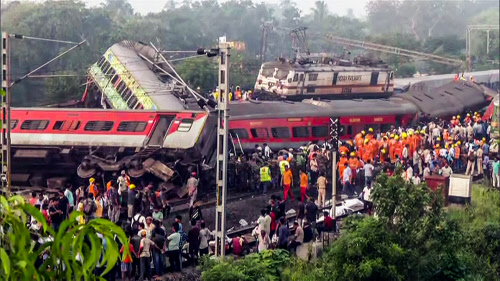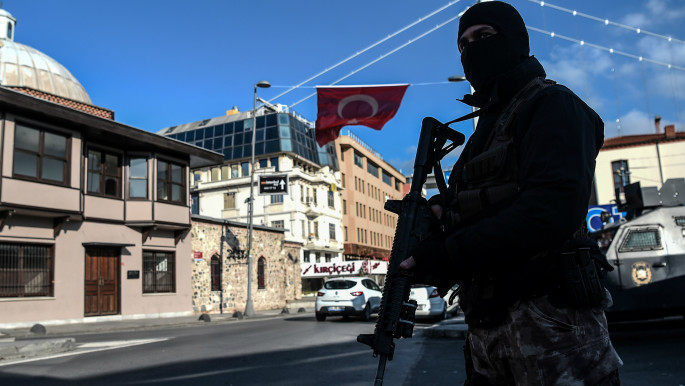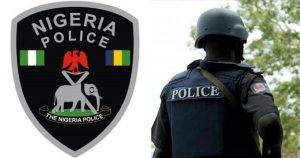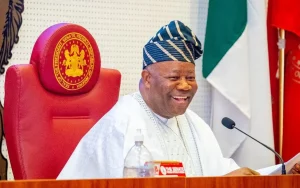Two Passenger Trains Derail In Eastern India, 300 Dead, 900 Injured
Rescuers waded through piles of debris and wreckage to pull out bodies and free people on Saturday after two passenger trains derailed in India, killing more than 300 people and injuring hundreds as rail cars were flipped over and mangled in one of the country’s deadliest train crashes in decades.
The accident, which happened about 220 kilometers (137 miles) southwest of Kolkata on Friday night, led to a chaotic scene as rescuers climbed atop the wrecked trains to break open doors and windows using cutting torches to free survivors.
About 900 people were injured in the accident in Balasore district in the eastern state of Odisha, said P.K. Jena, the state’s top administrative official. The cause was under investigation.
At least 300 bodies were recovered overnight and into Saturday morning, Sudhanshu Sarangi, director of Odisha’s fire and emergency department, told The Associated Press. He said more than 800 injured passengers were taken to various hospitals with many in critical condition.
Army soldiers and air force helicopters joined the relief effort along with local authorities.
About 200 severely injured people were transferred to specialty hospitals in other cities in the state, Jena said. Another 200 people were discharged after receiving medical care and the rest were being treated in local hospitals, he added.
“The challenge now is identifying the bodies. Wherever the relatives are able to provide evidence, the bodies are handed over after autopsies. If not identified, maybe we have to go for a DNA test and other protocols,” he said.
Rescuers were cutting through the destroyed rail cars to find people who may still be trapped. Sarangi said it was possible that people were stuck underneath but that it was unlikely they would still be alive. Late Friday, hundreds were trapped inside more than a dozen wrecked carriages as rescuers worked to pull them out.
“By 10 p.m. (on Friday) we were able to rescue the survivors. After that it was about picking up dead bodies,” he said. “This is very, very tragic. I have never seen anything like this in my career.”
Ten to 12 coaches of one train derailed, and debris from some of the mangled coaches fell onto a nearby track, said Amitabh Sharma, a railroad ministry spokesperson. The debris was hit by another passenger train coming from the opposite direction, causing up to three coaches of the second train to also derail, he added.
A third train carrying freight was also involved, the Press Trust of India reported, but there was no immediate confirmation of that from railroad authorities. PTI said some of the derailed passenger coaches hit cars from the freight train.
The death toll rose steadily throughout the night as footage showed shattered carriages that had overturned completely. Scores of dead bodies, covered by white sheets, lay on the ground near the train tracks as locals and rescuers raced to help survivors.
Teams of rescuers and police continued sifting through the ruins on Saturday morning as the search operation carried on, amid fears that the death toll is likely to rise further. Scores of people also showed up at a local hospital to donate blood.
The rescue operation was slowed because two train cars were pressed together by the impact of the accident, Jena said.
“We are cutting some portions of the (rail cars) and carefully searching for survivors,” he said, adding the search operation would likely conclude later Saturday.
Officials said 1,200 rescuers worked with 115 ambulances, 50 buses and 45 mobile health units through the night at the accident site. Saturday was declared as a day of mourning in Odisha as the state’s chief minister, Naveen Patnaik, reached the district to meet injured passengers.
Villagers said they rushed to the site to evacuate people after hearing a loud sound created by the train coaches going off the tracks.
“The local people really went out on a limb to help us. They not only helped in pulling out people, but retrieved our luggage and got us water,” PTI cited Rupam Banerjee, a survivor, as saying.
Passenger Vandana Kaleda said that inside the train during the derailment people were “falling on each other” as her coach shook violently and veered off the tracks.
“As I stepped out of the washroom, suddenly the train tilted. I lost my balance. … Everything went topsy turvy. People started falling on each other and I was shocked and could not understand what happened. My mind stopped working,” she said, adding she felt lucky to survive.
Another survivor who did not give his name said he was sleeping when the impact woke him up. He said he saw other passengers with broken limbs and disfigured faces.
The collision involved two trains, the Coromandel Express traveling from Howrah in West Bengal state to Chennai in Tamil Nadu state and the Howrah Superfast Express traveling from Bengaluru in Karnataka to Howrah, officials said. It was not immediately clear which derailed first.
Also Read: Money Laundering: Former Brazilian President, Fernando Collor de Mello Jailed for 8 Years
Despite government efforts to improve rail safety, several hundred accidents occur every year on India’s railways, the largest train network under one management in the world.
In August 1995, two trains collided near New Delhi, killing 358 people in one of the worst train accidents in India.
In 2016, a passenger train slid off the tracks between the cities of Indore and Patna, killing 146 people.
Most train accidents are blamed on human error or outdated signaling equipment.
More than 12 million people ride 14,000 trains across India every day, traveling on 64,000 kilometers (40,000 miles) of track.













